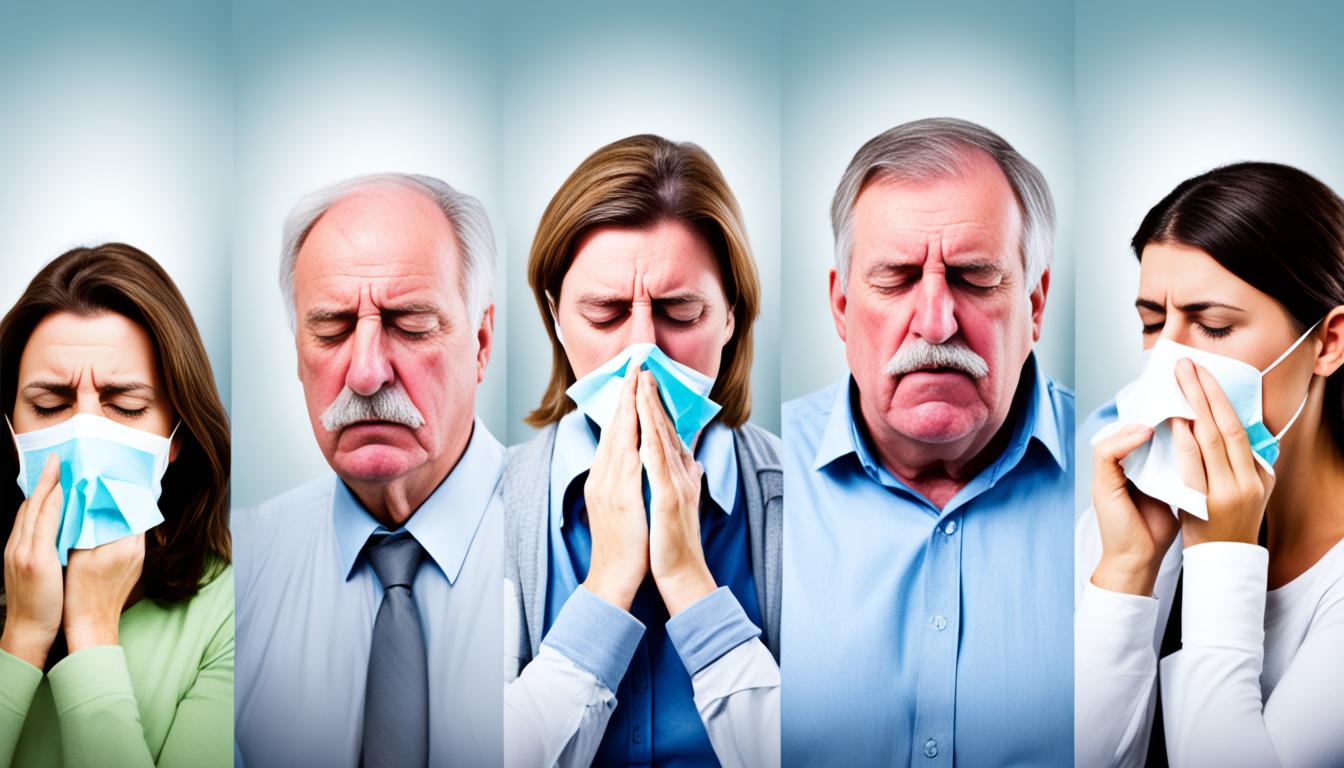Influenza H1N1, also known as Swine flu, is a contagious respiratory disease. It first appeared in pigs then spread to people, causing a widespread outbreak in 2009. The virus is a mix of swine, bird, and human flu viruses. It spreads from person to person mostly through the air or by touching surfaces.
H1N1 has led to many illnesses and deaths around the world. It is more dangerous than the seasonal flu. Luckily, a new treatment, stem cell therapy, shows promise in fighting this and other dangerous respiratory viruses.
Key Takeaways:
- Influenza H1N1, also known as Swine flu, is an acute respiratory infectious disease caused by a variant of the influenza virus.
- The virus originated from pigs and rapidly spread to humans, causing a pandemic outbreak in 2009.
- H1N1 contains gene segments from swine, avian, and human influenza viruses.
- The virus mainly spreads through direct and indirect contact or the respiratory tract.
- H1N1 has caused significant morbidity and mortality worldwide, with a higher death rate compared to common influenza.
- Stem cell therapy has emerged as a potential treatment for H1N1 and other respiratory viruses.
Symptoms of Influenza H1N1
Influenza H1N1, known as Swine flu, causes symptoms like regular flu. These include:
- Fever: A sudden high body temperature with chills and sweating.
- Cough: A cough that may be dry or produce phlegm.
- Sore throat: Throat discomfort that varies from mild to very sore.
- Runny or stuffy nose: It includes sneezing and nasal discharge.
- Body aches: Muscle and joint pain causing overall discomfort.
- Headache: Headaches may range from moderate to severe and can cause sensitivity to light and sound.
- Fatigue: Extreme tiredness and a lack of energy that can lead to sleepiness.
- Gastrointestinal symptoms: Some experience includes nausea, vomiting, and diarrhea.
Severe cases of H1N1 can lead to life-threatening issues. This includes viral pneumonia, respiratory failure, and organ failure. The severe case mortality rate is between 23 to 25%. Not everyone will have these severe symptoms. Some might experience a mild version or even nothing at all.
Now, let’s look at a table summarizing Influenza H1N1 symptoms:
| Symptom | Description |
|---|---|
| Fever | Sudden increase in body temperature. Chills and sweating are common. |
| Cough | A persistent cough may occur. It could be dry or bring up phlegm. |
| Sore throat | This symptom ranges from mild to severe throat pain. |
| Runny or stuffy nose | Nasal congestion with sneezing and discharge might be present. |
| Body aches | Feeling pain in muscles and joints adds to the discomfort. |
| Headache | Headaches could be moderate to severe and come with light and sound sensitivity. |
| Fatigue | There can be an extreme feeling of tiredness and a lack of energy. |
| Gastrointestinal symptoms | This could include feelings of nausea, vomiting, and diarrhea. |
Diagnosis and Treatment of Influenza H1N1
Influenza H1N1, known as the H1N1 virus or Swine flu, needs quick diagnosis and the right treatment. This helps manage symptoms and stops complications. This part gives an overview of how doctors find and treat H1N1.
Diagnosis of Influenza H1N1
To find out if someone has Influenza H1N1, doctors use lab tests. They take samples from the nose or throat to check for the virus. This testing is key to knowing if it’s H1N1 or something else.
If someone might have H1N1, they should get checked by a doctor soon. Getting the diagnosis early means they can start treatment right away. This can make the sickness less severe and stop it from spreading to others.
Treatment for Influenza H1N1
The main way to treat H1N1 is with antiviral drugs like oseltamivir (Tamiflu) and zanamivir (Relenza). These drugs slow down the virus and make the symptoms milder. They work best if started within two days of feeling sick.
Starting antiviral drugs early is very important. If you think you have H1N1, see a doctor right away. They can help choose the best treatment for you.
Getting vaccinated is also important to avoid H1N1. The H1N1 shot is part of the yearly flu vaccine. It’s especially recommended for people at high risk, like pregnant women and those with health problems.
After the vaccine, your body builds up protection against H1N1. This lowers your chances of getting sick. It’s critical to follow the vaccine guidelines to stay safe and stop the virus from spreading.
| Diagnosis | Treatment | Prevention |
|---|---|---|
| Laboratory testing | Antiviral medications | Vaccination |
| Collecting respiratory specimens | Early intervention | Compliance with immunization guidelines |
| Confirmation of H1N1 | Reducing severity and duration of symptoms | Protecting high-risk populations |
Stem Cell Therapy for Influenza H1N1
Stem cell therapy is giving hope in battles against influenza H1N1 and other viruses. It uses mesenchymal stem cells (MSCs) from various sources to heal lung damage from H1N1. These cells help calm down the body’s immune response and speed up healing.
MSCs can tweak the immune system to fight inflammation and help new tissues grow. This is really cool because it means lung injuries might heal better. Studies in animals show that treating H1N1 with MSCs can lower lung inflammation and improve breathing.
Right now, experts are hard at work in clinical trials to fully test the benefits and safety of stem cell therapy for H1N1. These trials are key to understanding if this approach could be a solid treatment. It’s worth mentioning, though, that using stem cells for H1N1 is still being researched. We need more studies to know just how well it works and what it means in the long run.

